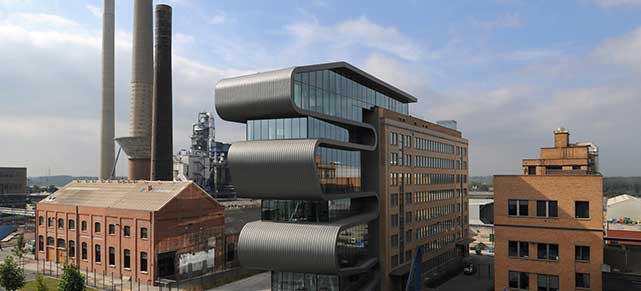For much of the 20th century, a company known as Union Minière du Haut Katanga exploited the rich mineral resources of Belgium’s colony in the Congo. The company mined copper, tin, cobalt and precious metals, and shipped them to its silver and lead refineries in the Hoboken section of Antwerp, Europe’s second biggest port. This dirty business took a hit when Union Minière’s assets in central Africa were seized by the government of Zaire in 1968, forcing the company to seek new mines.
The company, now called Umicore, is still mining and refining – but instead of extracting metals from the earth, it recovers them from the discards of the industrial economy: electronic waste, catalytic converters, rechargeable batteries, and residues from copper and zinc smelters. The Hoboken refineries have been shuttered, and in their place is what Umicore calls “the world’s most advanced, largest (116 hectares) and cleanest precious and specialty metals refining, recycling and recovery operation.”
The extreme makeover in Hoboken has helped Umicore reach the top of Corporate Knights’ 2013 list of the Global 100 Most Sustainable Companies. It’s part of Umicore’s top-to-bottom transformation from traditional mining company into an innovative technology firm that operates at the frontier of metallurgy, chemistry and materials science. Today, the company focuses on clean technologies, including emission-control catalysts, materials for rechargeable batteries and photovoltaics, and advanced recycling.
“Sustainability has been and remains an all-pervasive driver of our strategy and day-to-day actions,” says Marc Grynberg, chief executive of Umicore, in an email interview. “We don’t see sustainability as an add-on. It’s really a part of everything we do.”
Chances are, you don’t know Umicore, but the company’s products are everywhere on earth – and beyond. About one in three of the world’s cars are equipped with a Umicore catalytic converter, and about one in four of the world’s laptops and mobile phones have Umicore materials in their batteries, according to Tim Weekes, director of group communications. Umicore-manufactured germanium substrates – layers of a hard, lustrous metallic element – formed the base layer of the solar panels on NASA’s Mars Exploration Rovers, the robots that studied the red planet.
With revenues of about €14.5 billion (roughly $19 billion) in 2011, Brussels-based Umicore employs about 14,600 people and operates 77 industrial sites and 15 R&D and technical centres in 34 countries. Its operations are concentrated in Europe and Asia but it also runs nine factories in the United States and Canada.
While the company traces its history back to a zinc mine established in 1805, Umicore as it is now configured took shape during the 1990s and 2000s. “Umicore managed a complete transformation of its business mix,” Grynberg said. “We morphed from a commodity supplier into a premium provider of value-added solutions.” The company devised a new strategy intended to capitalize on four global megatrends: resource scarcity, electrified transportation, clean energy production and storage, and cleaner air.
A flurry of divestments and acquisitions followed. The company spun off or sold its copper and zinc businesses, and made a pair of acquisitions – PMG and Delphi Catalyst – to give it a major presence in the automotive catalysts business. It also invests heavily in research and development, spending about €157 million on R&D last year, the equivalent of more than 6 per cent of net revenues.
Umicore now operates four business units:
- Catalysis: Its catalysts reduce pollution from cars and trucks powered by internal combustion engines. Government air pollution standards, which are becoming stricter, help drive growth.
- Energy materials: These are engineered materials derived from cobalt, germanium and nickel that find their way into products like rechargeable batteries and photovoltaics.
- Performance materials: These are materials derived from zinc, platinum and other metals that are used in building products, fertilizer and fibreglass production.
- Recycling: The company recovers precious and non-ferrous metals from complex waste streams, including industrial, electronic and consumer waste. This business, too, has been driven by regulation, particularly in the EU, where industries are required to take back and recycle e-waste.
Recycling is a very efficient way to produce metals, says the company, highlighting the benefits of “closing the materials loop.” From 50,000 mobile phones – around three tons of material, excluding batteries – Umicore is able to recycle around one kilogram of gold, 10 kilograms of silver, 400 grams of palladium and 420 kilograms of copper. By contrast, extracting one kilogram of gold from a mine below the ground requires the removal of 200 tons of rock.
To push efficiency further, Umicore is aiming for a 20 per cent reduction in its CO2 emissions from a base year of 2006. It had achieved a 14 per cent reduction by the end of 2011, adjusting for changes to the business; in absolute terms, it cut emissions by 6 per cent.
It ranked near the top in our survey in terms of energy, GHG, water and waste productivity.
Click here to go back to the ranking landing page.






